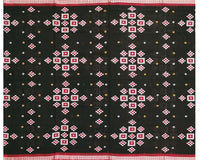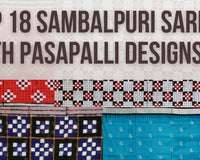A pasapali pata saree is an excellent choice if you want a saree that is elegant, comfortable, and versatile.
A pasapali pata saree is a type of handloom saree made of pure silk and embellished with intricate designs and motifs. Pasapali pata sarees are also known as bomkai sarees because they originate in the Bomkai village of Odisha's Ganjam district.
We'll tell you everything you need to know about pasapali pata sarees and how to look like a diva in them in this blog post.
What is a Pasapali Pata Saree and Why is it So Special?
A pasapali pata saree is a handloom saree made from fine silk yarns and woven using the extra weft technique. This technique involves inserting extra threads of various colours into the fabric's warp and weft to create intricate patterns and motifs.
Typically, the motifs are inspired by nature, such as flowers, animals, birds, fish, and so on, or by local culture and traditions, such as temples, chariots, dancers, and so on. Butis and butas are other names for the motifs.
Pasapali pata sarees are unique because they are created by skilled weavers who inherited the art of weaving from their forefathers. These beautiful sarees are created by weavers using traditional wooden looms and hand-operated jacquard machines. Depending on the complexity of the design, weaving a pasapali pata saree can take up to 15 days or more.
Each pasapali pata saree is one-of-a-kind, with its own charm and personality. Pasapali pata sarees can be worn casually or formally and are suitable for all seasons and occasions.
The Fascinating History and Origin of the Pasapali Saree
The pasapali saree's history and origin can be traced back to the 16th century, when Mughal emperor Akbar invaded Odisha and was impressed by the region's handloom fabrics. He invited some weavers to his court and supported their trade. He also incorporated Persian elements into the designs and motifs of Odisha handloom fabrics.
Bhagabat Meher, a weaver from the Meher community in Bomkai village, was one of the weavers who went to Akbar's court. He learned the extra weft technique from Persian weavers and incorporated it into his own weaving style.
He also used Mughal motifs in his designs, such as paisley and lotus. He returned to his village and taught the new technique and style to his fellow weavers. As a result, the pasapali saree was born.
The name pasapali is derived from two words: pasa (chess board) and pali (border). The name alludes to the distinct checkered pattern on the border of these sarees. Using contrasting thread colours in the extra weft technique, the checkered pattern is created. Many people consider the checkered border to be auspicious and lucky.
The pasapali saree quickly gained popularity among Odisha's royal families and nobility, particularly during the reign of Maharaja Krushna Chandra Gajapati Narayan Dev (1892-1974), an avid patron of art and culture. He marketed the pasapali saree as a symbol of Odisha's history and identity. He also gave these sarees to a number of dignitaries and celebrities who came to Odisha.
The pasapali saree is now one of the most sought-after handloom sarees in India and around the world. It has appeared in numerous national and international exhibitions and fashion shows. Many famous people have worn it, including former Prime Minister Indira Gandhi, former President Pratibha Patil, actress Aishwarya Rai Bachchan, and others.
The Different Varieties and Styles of Pata Sarees in Odisha
Pasapali pata sarees aren't the only kind of pata sarees available in Odisha. Pata means cloth or fabric in Odia, and there are many different types and styles of pata sarees in Odisha, including:
- Sambalpuri pata sarees: These are the most well-known and widely worn pata sarees in Odisha. They are made of silk and use the tie-dye or ikat technique, which involves tying and dying the yarns prior to weaving them. These sarees' designs and motifs are very colourful and vibrant, depicting various themes such as nature, mythology, folklore, and so on.
- Kotpad pata sarees are dyed with natural colours extracted from the roots of the aul tree (Morinda citrifolia). The dyeing process is time-consuming and can take up to a month. These sarees are typically deep maroon or brown in colour, with white or cream motifs. The motifs are geometric or floral, and they are inspired by tribal art.
- Bomkai silk sarees: These are made of silk and, like the pasapali pata sarees, feature the extra weft technique. The motifs on these sarees, on the other hand, are more intricate and elaborate, and frequently include zari (gold or silver thread) work. The motifs are usually inspired by Odisha's temple architecture and sculptures. These sarees come in a variety of rich and royal colours, including red, green, and blue.
- Nuapatna pata sarees: like sambalpuri pata sarees, are made of cotton or silk and feature the ikat technique. The motifs on these sarees, on the other hand, are more subtle and refined, and frequently include religious symbols such as conch shells, wheels, lotuses, and so on. These sarees are soft and pastel in colours like pink, yellow, and peach.
How to Identify an Authentic Sambalpuri Pata Saree from a Fake One
Sambalpuri pata sarees are among the most sought-after and expensive pata sarees in Odisha. They are also among the most copied and imitated pata saree styles in India.
Many fake sambalpuri pata sarees are sold in the market as sambalpuri or ikat. These sarees are made of low-quality materials and use chemical dyes and prints rather than natural dyes and hand weaving. They fall short of the quality and beauty of authentic sambalpuri pata sarees.
So, how do you tell the difference between a genuine and a fake sambalpuri pata saree? Here are some pointers to get you started:
- Examine the fabric: An authentic sambalpuri pata saree is made of soft, smooth, and breathable pure cotton or silk. A fake sambalpuri pata saree is made of rough, stiff, and uncomfortable synthetic or mixed fabrics.
- Examine the dye: A genuine sambalpuri pata saree is dyed with natural colours extracted from plants, flowers, fruits, and so on. The colours are vibrant but not overpowering, and they fade gradually over time. A fake sambalpuri pata saree is dyed with artificial and harsh chemical colours that fade or bleed quickly.
- Examine the fine print: An authentic sambalpuri pata saree is woven with the tie-dye or ikat technique, which results in motifs with blurred or fuzzy edges. On both sides of the fabric, the motifs are symmetrical. The motifs on a fake sambalpuri pata saree are printed with machines that produce sharp or clear edges. On both sides of the fabric, the motifs are asymmetrical or distorted.
- Examine the cost: An authentic sambalpuri pata saree is pricey because it takes a long time, skill, and labour to create. A fake sambalpuri pata saree is less expensive because it takes less time, skill, and labour to make.
If you want to buy an authentic sambalpuri pata saree, always go to a reputable or certified seller who can provide you with a guarantee or certificate of authenticity.
You should also carefully inspect the saree before purchasing it, looking for any signs of defects or damage.
How Much Does a Pasapali Pata Saree Cost and Where to Buy It?
A pasapali pata saree is a valuable and exquisite piece of handloom art that can range in price from Rs. 5000-7000 to lakhs of rupees or more, depending on the saree's quality, design, and material. A pasapali pata saree is an investment that will last for generations because it is timeless and elegant.
If you want to buy a pasapali pata saree, you should always look for a reputable and authentic source that can provide you with a genuine and high-quality product. A pasapali pata saree can be purchased online or in person.
- A handloom store or cooperative society in your community that sells authentic and certified handloom products. Such stores or societies can be found in major cities or towns throughout Odisha.
- A website or online platform that sells authentic and certified handloom products. Such platforms or websites, such as odikala.com, can be found on the internet. You can order your desired pasapali pata saree online by browsing their catalogues. On some of these platforms or websites, you can also get discounts, offers, and free shipping.
The Cultural Significance and Popularity of the Pata Sarees in Odisha
Pata sarees are not only pieces of clothing in Odisha, but also pieces of culture and identity. They represent Odisha's and its people's rich and diverse heritage and traditions. They also reflect the skill and creativity of the weavers who make them.
Pata sarees in Odisha have a lot of cultural significance and popularity among Odishans and others. Some of the reasons for this are as follows:
- In Odisha, women of all ages, classes, castes, and religions wear them as a symbol of pride and dignity. On special occasions, men wear them as dhotis or lungis.
- In Odisha, they are associated with various festivals, rituals, ceremonies, and occasions such as Rath Yatra, Durga Puja, Nuakhai, Raja Parba, and so on. They are also given to relatives and friends on special occasions such as weddings, birthdays, and anniversaries.
- They are admired and appreciated by visitors from other states and countries who come to Odisha for tourism, business, education, and other reasons. They are also exported to various parts of the world where people who appreciate handloom products appreciate them.
Conclusion
We hope you learned something new about pasapali pata sarees after reading this blog post. Pasapali pata sarees are one of India's most beautiful and versatile handloom sarees, capable of making you look like a diva in any situation.
If you want to buy a pasapali pata saree or any other type of pata saree in Odisha, you can browse through our exclusive collection of handloom products. You can also contact us with any questions or comments. We would appreciate hearing from you.
Thank you for taking the time to read this blog post. Please forward it to any friends or family members who might be interested in pasapali pata sarees. Also, please leave a comment below to let us know what you think about pasapali pata sarees. We'd love to hear your thoughts and ideas.








